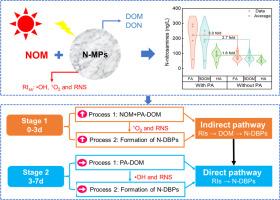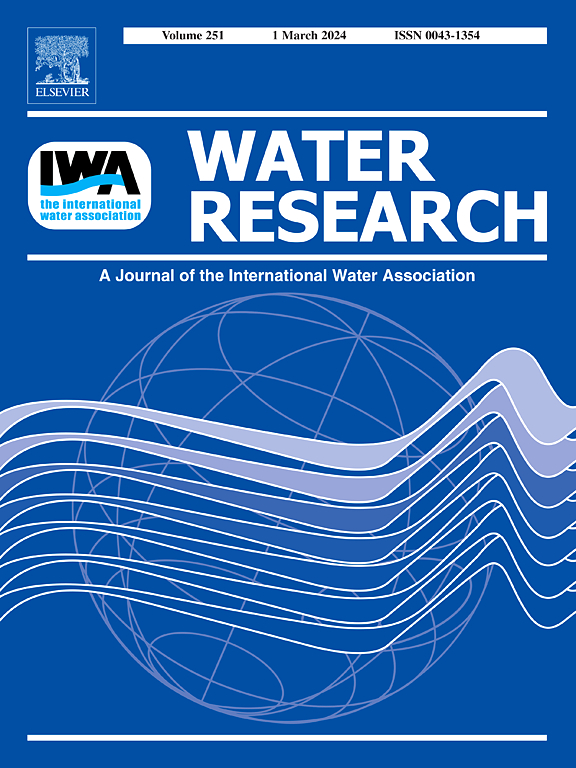含氮微塑料与水中天然有机物的光老化被忽视的风险:增加含氮消毒副产物的形成
IF 12.4
1区 环境科学与生态学
Q1 ENGINEERING, ENVIRONMENTAL
引用次数: 0
摘要
在水环境中,微塑料(MPs)经历光老化,释放溶解的有机物(DOM)。天然有机物(NOM)光转化产生消毒副产物(DBPs)已有报道。然而,NOM对MPs(特别是含氮MPs)光老化和随后的含氮DBPs (N-DBPs)形成的影响尚不清楚。本研究考察了聚酰胺(PA)与NOM(黄腐酸[FA]、腐植酸[HA]和生物炭衍生DOM [BDOM])对N-DBPs形成的影响。结果表明,FA+PA、BDOM+PA和HA+PA体系中形成的主要DBPs n -亚硝胺含量为3.0。与相应的NOM处理相比,分别高出2.7倍和1.6倍。NDMA是n -亚硝胺的主要种类,最高含量为202 ng/L,超过了世界卫生组织100 ng/L的指导值。第1阶段(0-3d)的主要反应中间体(RIs)为1O2和活性氮(RNS),第2阶段(3-7d)的主要反应中间体为•OH和RNS,淬灭实验证实了这一点。本文首次发现了N-DBPs在含n MPs光老化过程中的形成,并提出了N-DBPs形成的两阶段、两过程、两途径理论。这项工作强调了了解MPs和NOM在光老化过程中的相互作用对于更好地评估水环境中DBPs形成的风险的重要性。本文章由计算机程序翻译,如有差异,请以英文原文为准。


Overlooked risks of photoaging of nitrogenous microplastics with natural organic matter in water: Augmenting the formation of nitrogenous disinfection by-products
In aqueous environments, microplastics (MPs) undergo photoaging, releasing dissolved organic matter (DOM). Disinfection byproducts (DBPs) formation from natural organic matter (NOM) phototransformation has been reported. However, the impact of NOM on the photoaging of MPs (especially nitrogen-containing MPs) and subsequent nitrogenous DBPs (N-DBPs) formation remains unknown. Herein, this study investigated polyamide (PA) with NOM (fulvic acid [FA], humic acid [HA] and biochar-derived DOM [BDOM]) on N-DBPs formation. Results showed that the levels of the main DBPs, N-nitrosamine, formed in the FA+PA, BDOM+PA, and HA+PA systems were 3.0. 2.7 and 1.6 folds higher, respectively, compared to those in the corresponding NOM treatments. NDMA was found to be the dominant N-nitrosamine species, with the highest level of 202 ng/L, exceeding the WHO guideline of 100 ng/L. The main reactive intermediates (RIs) were 1O2 and reactive nitrogen species (RNS) during the first stage (0–3d), and •OH and RNS during the second stage (3–7d), which were confirmed by quenching experiment. For the first time, we found the formation of N-DBPs during photoaging of N-containing MPs, and proposed a two-stages, two-processes, and two-pathways theory of N-DBPs formation. This work emphasizes the importance to understand the interactions between the MPs and NOM in photoaging to better assess the risk of DBPs formation in aqueous environment.
求助全文
通过发布文献求助,成功后即可免费获取论文全文。
去求助
来源期刊

Water Research
环境科学-工程:环境
CiteScore
20.80
自引率
9.40%
发文量
1307
审稿时长
38 days
期刊介绍:
Water Research, along with its open access companion journal Water Research X, serves as a platform for publishing original research papers covering various aspects of the science and technology related to the anthropogenic water cycle, water quality, and its management worldwide. The audience targeted by the journal comprises biologists, chemical engineers, chemists, civil engineers, environmental engineers, limnologists, and microbiologists. The scope of the journal include:
•Treatment processes for water and wastewaters (municipal, agricultural, industrial, and on-site treatment), including resource recovery and residuals management;
•Urban hydrology including sewer systems, stormwater management, and green infrastructure;
•Drinking water treatment and distribution;
•Potable and non-potable water reuse;
•Sanitation, public health, and risk assessment;
•Anaerobic digestion, solid and hazardous waste management, including source characterization and the effects and control of leachates and gaseous emissions;
•Contaminants (chemical, microbial, anthropogenic particles such as nanoparticles or microplastics) and related water quality sensing, monitoring, fate, and assessment;
•Anthropogenic impacts on inland, tidal, coastal and urban waters, focusing on surface and ground waters, and point and non-point sources of pollution;
•Environmental restoration, linked to surface water, groundwater and groundwater remediation;
•Analysis of the interfaces between sediments and water, and between water and atmosphere, focusing specifically on anthropogenic impacts;
•Mathematical modelling, systems analysis, machine learning, and beneficial use of big data related to the anthropogenic water cycle;
•Socio-economic, policy, and regulations studies.
 求助内容:
求助内容: 应助结果提醒方式:
应助结果提醒方式:


